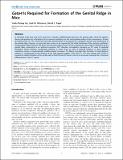Gata4 Is Required for Formation of the Genital Ridge in Mice
Author(s)
Hu, Yueh-Chiang; Okumura, Leah M.; Page, David C
DownloadHu-2013-Gata4 is required fo.pdf (10.42Mb)
PUBLISHER_POLICY
Publisher Policy
Article is made available in accordance with the publisher's policy and may be subject to US copyright law. Please refer to the publisher's site for terms of use.
Terms of use
Metadata
Show full item recordAbstract
In mammals, both testis and ovary arise from a sexually undifferentiated precursor, the genital ridge, which first appears during mid-gestation as a thickening of the coelomic epithelium on the ventromedial surface of the mesonephros. At least four genes (Lhx9, Sf1, Wt1, and Emx2) have been demonstrated to be required for subsequent growth and maintenance of the genital ridge. However, no gene has been shown to be required for the initial thickening of the coelomic epithelium during genital ridge formation. We report that the transcription factor GATA4 is expressed in the coelomic epithelium of the genital ridge, progressing in an anterior-to-posterior (A-P) direction, immediately preceding an A-P wave of epithelial thickening. Mouse embryos conditionally deficient in Gata4 show no signs of gonadal initiation, as their coelomic epithelium remains a morphologically undifferentiated monolayer. The failure of genital ridge formation in Gata4-deficient embryos is corroborated by the absence of the early gonadal markers LHX9 and SF1. Our data indicate that GATA4 is required to initiate formation of the genital ridge in both XX and XY fetuses, prior to its previously reported role in testicular differentiation of the XY gonad
Date issued
2013-07Department
Massachusetts Institute of Technology. Department of Biology; Whitehead Institute for Biomedical ResearchJournal
PLoS Genetics
Publisher
Public Library of Science
Citation
Hu, Yueh-Chiang, Leah M. Okumura, and David C. Page. “Gata4 Is Required for Formation of the Genital Ridge in Mice.” Edited by R. Scott Hawley. PLoS Genetics 9, no. 7 (July 11, 2013): e1003629.
Version: Final published version
ISSN
1553-7404
1553-7390